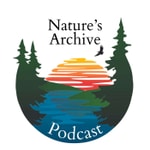Nature's Archive – Details, episodes & analysis
Podcast details
Technical and general information from the podcast's RSS feed.

Nature's Archive
Michael Hawk
Frequency: 1 episode/15d. Total Eps: 121

Nature’s Archive, hosted by Michael Hawk, delves into the beauty and complexity of the natural world through interviews with ecologists, naturalists, educators, authors, and researchers. Each episode inspires curiosity and reveals nature’s surprising nuances. Part of Jumpstart Nature, a movement empowering everyone to support the environment, this podcast invites you to connect with nature like never before.
Recent rankings
Latest chart positions across Apple Podcasts and Spotify rankings.
Apple Podcasts
🇺🇸 USA - nature
28/07/2025#76🇺🇸 USA - nature
27/07/2025#85🇺🇸 USA - nature
25/07/2025#75🇺🇸 USA - nature
24/07/2025#59🇺🇸 USA - nature
23/07/2025#37🇺🇸 USA - nature
22/07/2025#87🇺🇸 USA - nature
21/07/2025#93🇺🇸 USA - nature
20/07/2025#73🇺🇸 USA - nature
19/07/2025#86🇺🇸 USA - nature
18/07/2025#56
Spotify
No recent rankings available
Shared links between episodes and podcasts
Links found in episode descriptions and other podcasts that share them.
See all- https://incompetech.filmmusic.io/
770 shares
- https://merlin.allaboutbirds.org/
207 shares
- https://www.inaturalist.org/
134 shares
RSS feed quality and score
Technical evaluation of the podcast's RSS feed quality and structure.
See allScore global : 58%
Publication history
Monthly episode publishing history over the past years.
#102: Sophie Osborn - From the Brink: Reintroducing Endangered Birds
lundi 2 septembre 2024 • Duration 01:12:56
Have you ever wondered what it takes to bring a species back from the brink of extinction? Today, we’re diving into the front lines of one of the most challenging and inspiring conservation efforts of our time, with Sophie Osborn as our guide. This episode unravels the incredible stories of the Peregrine Falcon, Hawaiian Crow, and California Condor—three iconic birds with a common thread of survival against the odds.
We’ll explore the daunting threats these birds have faced, and surprisingly, how those same dangers continue to impact us all. Take lead ammunition, for instance—it’s a well-known hazard to wildlife like the Condor. But did you know that the tiny fragments left behind in game can be ingested by people, leading to serious health risks? You’ll find a striking X-ray image in our show notes that drives this point home.
But this isn’t just a tale of challenges—it’s also a story of hope. Sophie shares the hard-won successes and the relentless dedication of biologists who are making a difference. Sophie discussed all of this and much more in her new book, ‘Feather Trails’. It’s a beautifully crafted narrative that blends humor and suspense, along with Sophie’s personal journey alongside these remarkable species. Trust me, it’s well worth the read.
Be sure to check out Sophie’s work at wordsforbirds.net, and her Substack blog, ‘Words for Birds.’
FULL SHOW NOTES with photos
Links from Today's Episode
Feather Trails: A Journey of Discovery Among Endangered Birds - Sophie Osborn's most recent book
Sophie's Substack Blog: Words for Birds
Sophie's website: wordsforbirds.net
Vocalizations of the Hawaiian Crow
Note: links to books are affiliate links to Bookshop.org. You can support independent bookstores AND Jumpstart Nature by purchasing through our affiliate links or our bookshop store.
Related Podcast Episodes
Condors with Tiana Williams-Claussen (Golden State Naturalist Crossover!)
CREDITS:
Thanks to Kat Hill for editing help with this episode!
Support Us On Patreon!
Buy our Merch!
Music: Spellbound by Brian Holtz Music
License (CC BY 4.0): https://filmmusic.io/standard-license
Artist site: https://brianholtzmusic.com
Discover the Jumpstart Nature Podcast - entertaining and immersive, it's the nature fix we all need.
Check past Nature's Archive episodes for amazing guests like Doug Tallamy, Elaine Ingham, and Rae Wynn-Grant, covering topics from bird migration to fungi to frogs and bats!
#101: Connecting Climate, Carbon, Tree Leaf Phenology and Genetics with Dr. Hanna Makowski
lundi 19 août 2024 • Duration 01:01:06
Have you ever wondered how biologists figure out how plants respond to drought, heat, cold, and other environmental factors?
One way is to study phenology. That’s a fancy word that accounts for seasonal and cyclical growth patterns of plants and animals. Researchers can look at various attributes, like when a plant flowers, leafs out, drops leaves, and more, and then see how that correlates to environmental factors, weather, climate, and genetics.
Today, our guest is Dr. Hanna Makowski, and she tells us all about her research at Black Rock Forest in New York - and why she’s had to become proficient with a shotgun!
Dr. Makowski shares her work on understanding the variations in leaf-out and leaf-drop phases among trees, the genetic and environmental factors driving these changes, and the broader implications for biodiversity and climate change adaptation.
Black Rock Forest is a special place for this kind of research, because it is at a transition zone where southern species and northern species meet. I know that I want to visit if I ever find myself in that part of New York.
Dr. Makowski’s findings could be helpful for tree conservation efforts and predicting forest resilience in the face of global climate shifts.
You can find Dr. Makowski on her website at www.hannamakowski.com, on twitter @hannamakowski, and on LinkedIn.
FULL SHOW NOTES
LINKS
Black Rock Forest
Hillary Cooper - Dr. Makowski referenced Hillary Cooper’s study on Fremont Cottonwood phenology
Sarah Fitzpatrick of Michigan State
The Yard of the Future Podcast
Support Us On Patreon!
Buy our Merch!
Music: Spellbound by Brian Holtz Music
License (CC BY 4.0): https://filmmusic.io/standard-license
Artist site: https://brianholtzmusic.com
Discover the Jumpstart Nature Podcast - entertaining and immersive, it's the nature fix we all need.
Check past Nature's Archive episodes for amazing guests like Doug Tallamy, Elaine Ingham, and Rae Wynn-Grant, covering topics from bird migration to fungi to frogs and bats!
#93: Dr. Rae Wynn-Grant - Carnivore Ecology, Wild Life, and Environmental Justice
lundi 25 mars 2024 • Duration 42:15
My guest today is Dr. Rae Wynn-Grant. Dr. Wynn-Grant is the co-host of Mutual of Omaha’s Wild Kingdom, is a wildlife ecologist and affiliated researcher at the UC Santa Barbara Bren School of Environmental and Science Management.
She’s also an author, with her new memoir entitled “Wild Life” coming out on April 2.
Today we discuss Dr. Wynn-Grant’s unique and inspiring personal journey into wildlife ecology, her awakening to the world of environmental justice, triggered by Hurricane Katrina, as well as some of her active research pursuits, including her work with bears and mountain lions that seem to have a propensity for visiting the beach.
I really enjoyed both the book and the conversation today, because Dr. Wynn-Grant has so many facets of her story that I can relate to, and that I find inspiring, and I think you will too.
Find Dr. Wynn-Grant on Instagram, Facebook, TikTok, or her website.
FULL SHOW NOTES
LINKS
Dangermond Preserve
Going Wild Podcast
Mapping Environmental Justice
Wild Life - Finding My Purpose in an Untamed World - by Rae Wynn-Grant
Thanks to Kat Hill for editing help on this episode.
Support Us On Patreon!
Buy our Merch!
Music: Spellbound by Brian Holtz Music
License (CC BY 4.0): https://filmmusic.io/standard-license
Artist site: https://brianholtzmusic.com
Discover the Jumpstart Nature Podcast - entertaining and immersive, it's the nature fix we all need.
Check past Nature's Archive episodes for amazing guests like Doug Tallamy, Elaine Ingham, and Rae Wynn-Grant, covering topics from bird migration to fungi to frogs and bats!
#3: Jan Hintermeister - Volunteering to Grow Your Impact
lundi 6 juillet 2020 • Duration 56:18
Jan Hintermeister is a prolific volunteer in many environmental causes and organizations in the San Francisco Bay Area. Jan has been a long time field volunteer and served multiple terms as the Board Chair for the non-profit San Francisco Bay Bird Observatory. He's been a County Parks Commissioner, a member of the Santa Clara Valley Open Space Authority Citizen Advisory Committee, was instrumental in establishing a unique 40 acre open space preserve in what is now the shadow of Levi Stadium, home of the San Francisco 49’ers, and banded at the Golden Gate Raptor Observatory, and much more.
Jan also has many years of experience as a field trip leader and open space docent, too.
Jan shows us that you can maintain your day job and still drive meaningful change through volunteering. We discuss this balance between Jan's Silicon Valley engineering career and his volunteering - how he started and grew his engagement and impact in both direct environmental efforts, and through engaging in the political side. Jan offers a lot of very practical advice for engaging locally and making an impact.
Music Credits
Opening - Fearless First by Kevin MacLoed
Closing - Beauty Flow by Kevin MacLoed
Both can be obtained from https://incompetech.filmmusic.io/
#2: Matthew Dodder - From Silicon Valley to Audubon Chapter Director
lundi 6 juillet 2020 • Duration 57:17
Matthew Dodder is the Executive Director of the Santa Clara Valley Audubon Society - but that is just the tip of the iceberg. Matthew's journey into the world of nature conservation and education began with a blizzard in Massachusetts. Matthew's journey took him through seminary school and into a career in graphic design and marketing in Silicon Valley.
He never lost his interest in birds and ecology, spending his free time teaching birding and ornithology, and creating fantastic art work and bird-oriented products. Eventually, the preparation met opportunity, and Matthew was able to transition his career and take on the challenge of leading one of the largest Audubon chapters in California.
This episode covers all of that, how COVID-19 is causing Audubon to change and adapt, and much more, including how to use a melon to avoid a deadly bird encounter. Yes, you read that correctly - be sure to stay tuned for that!
Find Matthew's artwork on his website, and learn more about the Santa Clara Valley Audubon Society.
Music Credits:
Opening: Fearless First by Kevin MacLoed
Closing: Beauty Flow by Kevin MacLoed
https://incompetech.filmmusic.io/
#1: Dorian Anderson - 17830 Miles of Biking for Birds
lundi 6 juillet 2020 • Duration 01:05:26
You may already know Dorian Anderson from his epic 2014 Biking for Birds adventure - 17830 miles over 365 days, through blizzards, heat waves and crazy drivers. The goal of this trip was to see as many bird species as possible (called a Big Year) in order to reset his life and simultaneously raise money and awareness for the environment and "green" ways to enjoy it.
Dorian has a fascinating back story including a high stakes academic career including a post-doctorate at Massachusetts General and Harvard Medical School, a battle with alcoholism and drugs, an early love of nature, and is quite a photographer, too.
This episode covers all of that and more, including Dorian's approach to risk taking and discussion of his upcoming projects.
Find Dorian on Instagram and on his photography site.
FULL SHOW NOTES
Links
People and Organizations
Listed in order of mention on the podcast.
Mark Kudrav, who had a California bicycle Big Year in 2013
Noah Stryker, who performed an International Big Year, and his book Birding Without Borders
The American Birding Association
The Conservation Fund
Victor Emanual Nature Tours
Christian Hagenlocher – The Birding Project, a funds-limited Big Year
The Speckled Hatchback, Dorian’s blog
Books
Note: links to books are affiliate links
Birding Without Borders, Noah Strycker’s wonderful book about an International Big Year.
Support Us On Patreon!
Buy our Merch!
Music: Spellbound by Brian Holtz Music
License (CC BY 4.0): https://filmmusic.io/standard-license
Artist site: https://brianholtzmusic.com
Discover the Jumpstart Nature Podcast - entertaining and immersive, it's the nature fix we all need.
Check past Nature's Archive episodes for amazing guests like Doug Tallamy, Elaine Ingham, and Rae Wynn-Grant, covering topics from bird migration to fungi to frogs and bats!
#92: Secrets of Beautifully Fuzzy Velvet Ants with Dr. Joseph Wilson (and a bit about native bees, too!)
lundi 11 mars 2024 • Duration 01:10:15
Have you ever seen a fuzzy looking ant? Maybe it looked like a little pipe cleaner with fuzzy red or yellow hair?
If so, you probably saw a velvet ant. And here’s the thing - it’s not even an ant at all. They’re wingless wasps, and they often turn up along hiking trails, roadsides, and sometimes even in your backyard! And if you haven’t seen one, hit pause and check out the show notes on naturesarchive.com for a few photos.
What’s more, these wasps have quite the reputation and an amazing natural history.
With me today is Dr. Joseph Wilson, an evolutionary ecologist and associate professor of biology at Utah State University. Dr. Wilson is also the co-author of the new book, Velvet Ants of North America, as well as the wildly popular The Bees in Your Backyard.
I reached out to Dr. Wilson because I’ve always been fascinated with velvet ants, but found precious little information about them. I purchased the book and reached out to Dr. Wilson, and he graciously agreed to share some of his knowledge.
For example, did you know that some velvet ants have an auditory warning? And half of velvet ants are nocturnal? We discuss why we seem to usually see velvet ants deterministically wandering near trails, why they are often - and inaccurately - called cow killers, and more.
But I couldn’t have a chat with Dr. Wilson and not talk bees, so we kick things off with some discussion of bees, buzz pollination and more before transitioning to velvet ants.
Find Dr. Wilson on The Bees in Your Backyard, Facebook, Instagram, and Twitter.
FULL SHOW NOTES
MORE LINKS
Also check out our interview with Krystle Hickman (episode #66) - about finding and photographing native bees.
The Bees in Your Backyard by Olivia Messinger Carril and Joseph Wilson
Common Bees of Western North America
Common Bees of Eastern North America
Velvet Ants of North America by Williams, Pan, and Wilson
Note: books are affiliate links to Bookshop.org. Support independent bookstores AND Jumpstart Nature by purchasing through these links or our bookshop store.
Other Insect-oriented Podcasts
Just Bugs
Bug Banter
Bugs Need Heroes
Support Us On Patreon!
Buy our Merch!
Music: Spellbound by Brian Holtz Music
License (CC BY 4.0): https://filmmusic.io/standard-license
Artist site: https://brianholtzmusic.com
Discover the Jumpstart Nature Podcast - entertaining and immersive, it's the nature fix we all need.
Check past Nature's Archive episodes for amazing guests like Doug Tallamy, Elaine Ingham, and Rae Wynn-Grant, covering topics from bird migration to fungi to frogs and bats!
#91: Examining Tree Physiology with Dr. Lucy Kerhoulas: Insights into Drought Adaptation and the Carbon Smoking Gun
lundi 26 février 2024 • Duration 01:01:59
In nature, tree physiology is like the engine that keeps forests running smoothly, similar to how human physiology keeps our bodies going. Just as we study how our bodies' metabolism, respiratory systems, and other systems work to keep us healthy, biologists can look at tree physiology to understand how trees grow, use energy, and cope with challenges in their environment.
Today’s guest, Dr. Lucy Kerhoulas, is an Associate Professor of Forest Ecophysiology at Cal-Poly Humboldt. She specializes in the forest physiology of northwestern California, which includes redwoods, Douglas fir, oaks, and more.
Today Dr. Kerhoulas explores various aspects of forest physiology including how they adapt to different conditions such as fire and drought. She delves into the scientific tools used to study how trees respond to environmental changes, including measuring carbon isotopes in tree tissues to assess impacts of drought. And this understanding of carbon isotope preferences provides interesting insights into historical atmospheric carbon levels, dating back hundreds of years. In fact, this is sometimes called “the smoking gun”, because it provides strong evidence of fossil fuel contributions to atmospheric carbon.
Dr. Kerhoulas also discusses how trees can share resources and signal each other during times of stress, possibly creating a cooperative environment within a forest.
This was a jam-packed discussion, and I hope you enjoy it.
FULL SHOW NOTES
Links to Topics Mentioned
Bigfoot Trail Alliance
CDFW
CNPS
CZU Complex Fire Map
Kerhoulas Forest Physiology Lab
Michael Kauffmann in Nature’s Archive Episode #41 discusses conifer trees and the Klamath Mountains
Thanks to Kat Hill for editing help in today's episode.
Support Us On Patreon!
Buy our Merch!
Music: Spellbound by Brian Holtz Music
License (CC BY 4.0): https://filmmusic.io/standard-license
Artist site: https://brianholtzmusic.com
Discover the Jumpstart Nature Podcast - entertaining and immersive, it's the nature fix we all need.
Check past Nature's Archive episodes for amazing guests like Doug Tallamy, Elaine Ingham, and Rae Wynn-Grant, covering topics from bird migration to fungi to frogs and bats!
#90: From Invasive Species to Allergenic Pollen with Allasandra Valdez (The Happy Botanist Podcast) and Dr. Daniel Katz
lundi 12 février 2024 • Duration 01:08:12
You’re in for a treat today - it’s like two episodes in one.
My guest today is Allasandra Valdez, a botanist working on her PhD in plant physiology in Cornell University’s Ecology and Evolutionary Biology department. Allasandra also has a background studying invasive species, and is the creator and host of The Happy Botanist podcast.
Today’s wide-ranging discussion touches on everything from studying plants' response to climate change through looking at carbon 13 isotopes, to invasive species including the Hemlock wooly adelgid, to the surprising behaviors of an invasive grass called Johnson Grass.
We also discuss Allasandra’s work in science communication and her podcast, The Happy Botanist.
As you know, my Jumpstart Nature organization seeks to amplify great work being done by others, and after meeting Allasandra and learning about her work and her vision, I felt that she fit the bill. So the last 30 minutes or so of today’s episode is a re-share of one of her episodes with Dr. Dan Katz. Dr. Katz studies airborne pollen - specifically allergenic pollen. If you’ve ever wondered why some pollen causes so much havoc, or if those pollen forecasts you sometimes see on the local weather are accurate, stay tuned to learn more.
Find Allasandra on Instagram and TikTok, and her podcast is on all of the usual podcast services, and the web at The Happy Botanist podcast.
FULL SHOW NOTES
Links
Daniel Katz: https://www.thekatzlab.com/
The Happy Botanist podcast
Support Us On Patreon!
Buy our Merch!
Music: Spellbound by Brian Holtz Music
License (CC BY 4.0): https://filmmusic.io/standard-license
Artist site: https://brianholtzmusic.com
Discover the Jumpstart Nature Podcast - entertaining and immersive, it's the nature fix we all need.
Check past Nature's Archive episodes for amazing guests like Doug Tallamy, Elaine Ingham, and Rae Wynn-Grant, covering topics from bird migration to fungi to frogs and bats!
#89: Burning Questions: Understanding Fire Management with Lenya Quinn-Davidson
lundi 29 janvier 2024 • Duration 01:15:11
Many of you might recall the dramatic 2020 fire season in the western USA. In California alone, close to 4 million acres burned. Cities were clouded with smoke and unhealthy air for many weeks. I had ash fall at my home in San Jose, CA on several occasions.
But did you know that based on pre-colonial historical estimates, 4 million acres burned would be considered “below average”. How can that be? Does that mean that every summer in the 1700’s had smoke filled air and devastating fires? Spoiler alert: the answer is no.
In today’s episode, we reconcile how it was possible for more acres of land to burn every year, but with less dramatic impact. In fact, that historical fire was largely beneficial to the land.
Our guest today, who helps us decipher historical fire and how we can add more beneficial fire back to the landscape is Lenya Quinn-Davidson.
And when you have a guest who’s first name literally means “firewood” in Spanish (alternative spelling), you know you’ve found the right person to discuss wildfire management.
But Lenya Quinn-Davidson’s qualifications extend well beyond her name. She’s the Director of the FIRE network for the University of California’s Agriculture and Natural Resources organization. She focuses on the various ways humans connect with fire, including the use of prescribed fire for habitat restoration, invasive species control, and ecosystem and community resiliency. She’s actively engaged in local and national prescribed fire communities, and is an advocate for increasing diversity in the world of wildfire.
A quick aside before we get into the interview. Obviously, climate change is a huge component for why we see bigger fires. Heat has a disproportionate impact on fire intensity. So while we don’t talk about climate change much today, it is absolutely an amplifying factor in wildfire intensity and frequency.
You can find Lenya at LenyaQD on twitter.
FULL SHOW NOTES
Links
California Prescribed Burn Associations
Dixie Fire
Scott Stephens - wildfire reconstructions from UC Berkeley
UCANR Fire Advisors
WTREX - Women-in-Fire Prescribed Fire Training Exchanges
Thanks to Kat Hill for editing help in this episode.
Support Us On Patreon!
Buy our Merch!
Music: Spellbound by Brian Holtz Music
License (CC BY 4.0): https://filmmusic.io/standard-license
Artist site: https://brianholtzmusic.com
Discover the Jumpstart Nature Podcast - entertaining and immersive, it's the nature fix we all need.
Check past Nature's Archive episodes for amazing guests like Doug Tallamy, Elaine Ingham, and Rae Wynn-Grant, covering topics from bird migration to fungi to frogs and bats!









